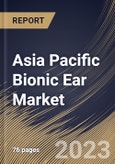A variety of assistive listening devices (ALDs), which improve hearing in difficult-to-hear settings, can be utilized with the majority of contemporary bionic ears, like cochlear implants. Examples of these circumstances include watching TV, conversing on the phone, or paying attention to a speaker or teacher. With an ALD, the audio processor receives the sound from gadgets like from an external microphone directly as opposed to the audio processor's microphone. For the user, this direct transmission enhances sound quality, making it simpler to stream music or converse on the phone.
ALDs can be found in a variety of accessories, including pens, neck loops, and customized battery pack covers. The majority of modern ALDs can wirelessly transmit audio to the audio processor after receiving sound from any Bluetooth device, like phones and PCs. Most cochlear implants can also be used with earlier ALD systems like telecoils.
In China, middle-aged and older individuals 45 years of age and older incurred direct costs associated with hearing loss in 2015, totaling $106.775 billion, accounting for 5.54% of the nation's total healthcare expenditures. Direct inpatient expenditures represented 18.87 to 24.25%, and direct outpatient costs ranged from 75.75 to 81.13% of the total direct costs associated with hearing loss. Therefore, in the coming years, the market will experience enormous growth owing to the rising prevalence of hearing impairment and rising healthcare expenditures.
The China market dominated the Asia Pacific Bionic Ear Market by Country in 2022 and would continue to be a dominant market till 2029; thereby, achieving a market value of $262.9 Million by 2029. The Japan market is poised to grow at a CAGR of 8.1% during (2023-2029). Additionally, The India market would exhibit a CAGR of 9.4% during (2023-2029).
Based on End-use, the market is segmented into Hospitals, Clinics, and Others. Based on Type, the market is segmented into Cochlear Implant, Auditory Brainstem Implants, and BAHA/BAHS. Based on countries, the market is segmented into China, Japan, India, South Korea, Singapore, Malaysia, and Rest of Asia Pacific.
The market research report covers the analysis of key stake holders of the market. Key companies profiled in the report include Cochlear Ltd., MED-EL GmbH, Sonova Holding AG, Zhejiang Uniview Technologies Co., Ltd. (Hangzhou Jiaozhi Technology Co., Ltd.), Boston Scientific Corporation, Medtronic PLC, Amplifon S.P.A., Starkey laboratories, Inc., GN Store Nord A/S (GN Hearing A/S), and WS Audiology A/S.
Scope of the Study
By End-use
- Hospitals
- Clinics
- Others
By Type
- Cochlear Implant
- Auditory Brainstem Implants
- BAHA/BAHS
By Country
- China
- Japan
- India
- South Korea
- Singapore
- Malaysia
- Rest of Asia Pacific
Key Market Players
List of Companies Profiled in the Report:
- Cochlear Ltd.
- MED-EL GmbH
- Sonova Holding AG
- Zhejiang Uniview Technologies Co., Ltd. (Hangzhou Jiaozhi Technology Co., Ltd.)
- Boston Scientific Corporation
- Medtronic PLC
- Amplifon S.P.A.
- Starkey laboratories, Inc.
- GN Store Nord A/S (GN Hearing A/S)
- WS Audiology A/S
Unique Offerings
- Exhaustive coverage
- The highest number of Market tables and figures
- Subscription-based model available
- Guaranteed best price
- Assured post sales research support with 10% customization free
Table of Contents
Companies Mentioned
- Cochlear Ltd.
- MED-EL GmbH
- Sonova Holding AG
- Zhejiang Uniview Technologies Co., Ltd. (Hangzhou Jiaozhi Technology Co., Ltd.)
- Boston Scientific Corporation
- Medtronic PLC
- Amplifon S.P.A.
- Starkey laboratories, Inc.
- GN Store Nord A/S (GN Hearing A/S)
- WS Audiology A/S
Methodology

LOADING...








